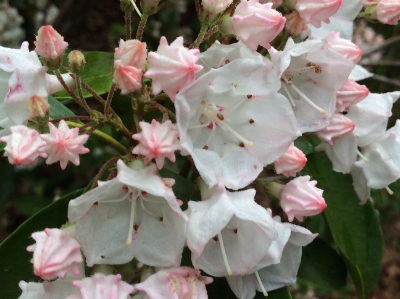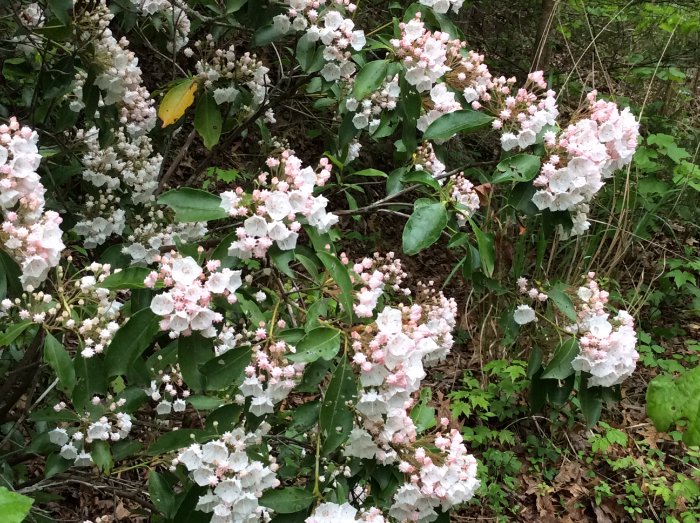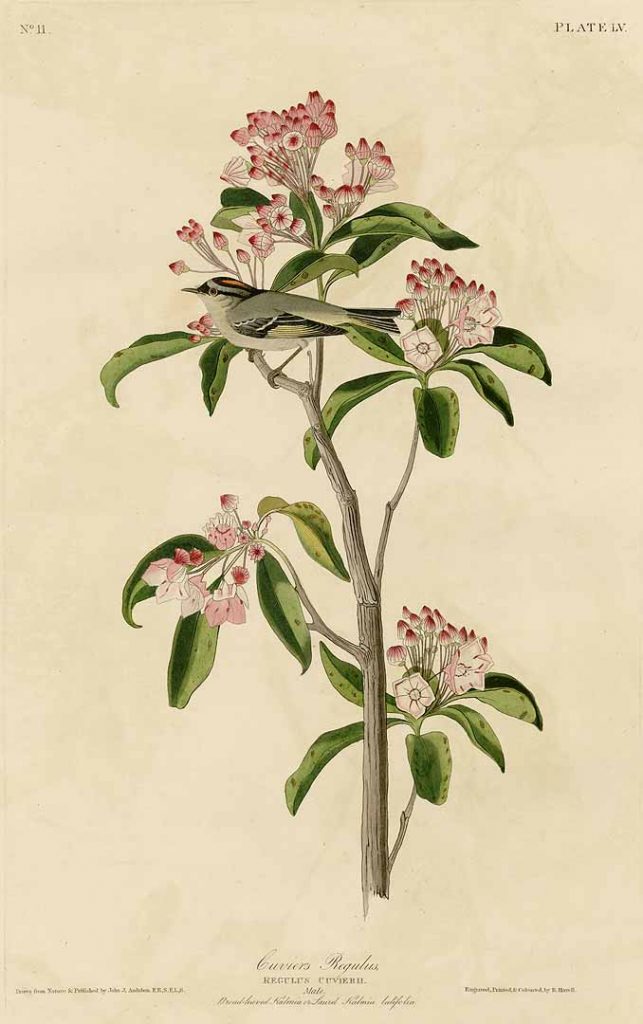
05.27.20 Laurel Hell
 Thickets of Mountain Laurel, Kalmia latifolia, are common in the Appalachian forest. These tough-branched shrubs can grow densely and often as high as twenty feet. To a foot traveler they are impenetrable, the groves are described as “laurel hells.” Some particularly remarkable stands are named for the unfortunate visitor who disappeared within. The mountain laurel has a fabulous pentagonal flower, described by some as a five-sided parasol. This is an apt description because as the five-sided blossom opens, ten stamens hooked into the petal sides are retracted and held under tension. These miniature catapults have been prepared to ensure that no visiting bumble bee will leave without a small cargo of pollen. The weight of the insect releases the spring-like stamen, which slams pollen onto the surprised bee. Mountain laurel is a characteristic plant of the Appalachian highlands and in a strange twist of language it lends its name to many creeks, hollows, and mountains. According to folklorist Tipper Pressley, mountain people called this plant “mountain ivy.” In my neighborhood we have several Ivy Creeks, all apparently named for the dense stands of laurel.
Thickets of Mountain Laurel, Kalmia latifolia, are common in the Appalachian forest. These tough-branched shrubs can grow densely and often as high as twenty feet. To a foot traveler they are impenetrable, the groves are described as “laurel hells.” Some particularly remarkable stands are named for the unfortunate visitor who disappeared within. The mountain laurel has a fabulous pentagonal flower, described by some as a five-sided parasol. This is an apt description because as the five-sided blossom opens, ten stamens hooked into the petal sides are retracted and held under tension. These miniature catapults have been prepared to ensure that no visiting bumble bee will leave without a small cargo of pollen. The weight of the insect releases the spring-like stamen, which slams pollen onto the surprised bee. Mountain laurel is a characteristic plant of the Appalachian highlands and in a strange twist of language it lends its name to many creeks, hollows, and mountains. According to folklorist Tipper Pressley, mountain people called this plant “mountain ivy.” In my neighborhood we have several Ivy Creeks, all apparently named for the dense stands of laurel.
 John James Audubon’s illustration of mountain laurel with a visiting “Cuvier’s Kinglet.” This bird is known as one of Audubon’s “mystery birds” since a bird matching his description has never been seen again. It is thought that Audubon was mistaken and that what he had collected was actually the similar golden-crowned kinglet.
John James Audubon’s illustration of mountain laurel with a visiting “Cuvier’s Kinglet.” This bird is known as one of Audubon’s “mystery birds” since a bird matching his description has never been seen again. It is thought that Audubon was mistaken and that what he had collected was actually the similar golden-crowned kinglet.
 Josef Beery
Josef Beery Thickets of Mountain Laurel, Kalmia latifolia, are common in the Appalachian forest. These tough-branched shrubs can grow densely and often as high as twenty feet. To a foot traveler they are impenetrable, the groves are described as “laurel hells.” Some particularly remarkable stands are named for the unfortunate visitor who disappeared within. The mountain laurel has a fabulous pentagonal flower, described by some as a five-sided parasol. This is an apt description because as the five-sided blossom opens, ten stamens hooked into the petal sides are retracted and held under tension. These miniature catapults have been prepared to ensure that no visiting bumble bee will leave without a small cargo of pollen. The weight of the insect releases the spring-like stamen, which slams pollen onto the surprised bee. Mountain laurel is a characteristic plant of the Appalachian highlands and in a strange twist of language it lends its name to many creeks, hollows, and mountains. According to folklorist Tipper Pressley, mountain people called this plant “mountain ivy.” In my neighborhood we have several Ivy Creeks, all apparently named for the dense stands of laurel.
Thickets of Mountain Laurel, Kalmia latifolia, are common in the Appalachian forest. These tough-branched shrubs can grow densely and often as high as twenty feet. To a foot traveler they are impenetrable, the groves are described as “laurel hells.” Some particularly remarkable stands are named for the unfortunate visitor who disappeared within. The mountain laurel has a fabulous pentagonal flower, described by some as a five-sided parasol. This is an apt description because as the five-sided blossom opens, ten stamens hooked into the petal sides are retracted and held under tension. These miniature catapults have been prepared to ensure that no visiting bumble bee will leave without a small cargo of pollen. The weight of the insect releases the spring-like stamen, which slams pollen onto the surprised bee. Mountain laurel is a characteristic plant of the Appalachian highlands and in a strange twist of language it lends its name to many creeks, hollows, and mountains. According to folklorist Tipper Pressley, mountain people called this plant “mountain ivy.” In my neighborhood we have several Ivy Creeks, all apparently named for the dense stands of laurel. John James Audubon’s illustration of mountain laurel with a visiting “Cuvier’s Kinglet.” This bird is known as one of Audubon’s “mystery birds” since a bird matching his description has never been seen again. It is thought that Audubon was mistaken and that what he had collected was actually the similar golden-crowned kinglet.
John James Audubon’s illustration of mountain laurel with a visiting “Cuvier’s Kinglet.” This bird is known as one of Audubon’s “mystery birds” since a bird matching his description has never been seen again. It is thought that Audubon was mistaken and that what he had collected was actually the similar golden-crowned kinglet.